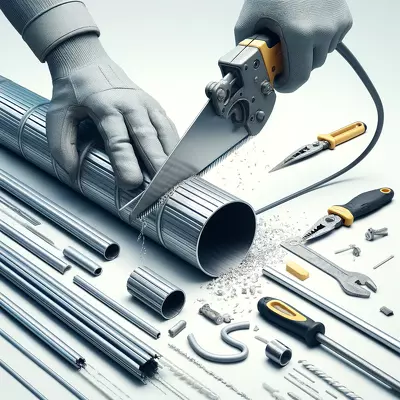From Novice to Pro: Elevating Your Skills in Metal Conduit Cutting
Whether you’re a seasoned professional or a DIY enthusiast, mastering the skill of cutting metal conduit is essential for anyone working on electrical installations or home improvement projects. This comprehensive guide provides straightforward steps to help you accurately and safely cut metal conduits, ensuring your projects meet safety standards and are executed with efficiency.
I. Introduction
Efficiently navigating the task of slicing through metal conduits is an indispensable skill for professionals and DIY enthusiasts alike, particularly in electrical installations and various construction endeavors. This article unfolds the essentials of cutting metal conduit, highlighting the importance of precision and safety, the diverse tools available, and techniques for different scenarios, ensuring your project’s success from the outset.
II. Understanding Metal Conduit
A. Types of Metal Conduit
Metal conduits are protective tubes that house and shield electrical wires, ensuring safety and integrity in electrical systems. They come in various types, including rigid metal conduit (RMC), electrical metallic tubing (EMT), and intermediate metal conduit (IMC), each serving distinct purposes and installation environments.
B. Importance of Cutting Metal Conduit Properly
Proper cutting of metal conduits is paramount to maintain the functionality and safety of electrical systems. Precise cuts ensure a snug fit and facilitate seamless connections between conduit sections, preventing damage to wires and reducing hazards.
C. Tools Needed for Cutting
A range of tools can be employed to cut metal conduits, including hacksaws, tubing cutters, and power saws. The choice of tool depends on the conduit’s material, thickness, and the precision required for the job.
III. Preparing to Cut Metal Conduit
A. Safety Measures
When cutting metal conduits, safety should always be your top priority. Wearing protective eyewear, gloves, and appropriate clothing is not just a suggestion; it’s a necessity. These safety measures are crucial in safeguarding against metal shards and potential cutting tool accidents, ensuring your well-being during the task.
B. Measuring and Marking the Conduit
Accurate measurement and marking are the first steps in ensuring a precise cut. A marker and a measuring tape are used to mark the cutting line, considering any necessary allowances for fittings.
C. Securing the Conduit
Securing the conduit with a vice or clamps prevents movement during cutting, ensuring accuracy and reducing the risk of injury.
IV. The Cutting Process
A. Using a Hacksaw
A hacksaw, equipped with a fine-toothed blade, is ideal for cutting thinner metal conduits. Steady, even strokes yield a clean cut through the conduit.
B. Utilizing a Tubing Cutter
A tubing cutter is preferred for a cleaner and more precise cut, especially on EMT. This tool provides a uniform cut around the conduit’s circumference with minimal effort.
C. Deburring the Edges
After cutting, deburring removes sharp edges, protecting wires from damage during installation. A file or deburring tool can be used for this purpose.
V. Advanced Techniques
A. Cutting Thick-Walled Conduit
Thick-walled conduits, such as RMC, may require power tools like a portable band saw or a reciprocating saw for efficient cutting.
B. Angled Cuts for Complex Installations
Angled cuts, necessary for complex installations, demand precision and practice. A miter box can assist in achieving accurate angles.
C. Using Power Tools
Power tools expedite the cutting process and are beneficial for large projects. Their use requires additional safety precautions, including hearing protection.
VI. Troubleshooting Common Issues
A. Dealing with Jagged Edges
Jagged edges can be smoothed with a file or an electric deburring tool to prevent damage to the wires or injury to the installer.
B. Correcting Misaligned Cuts
Misaligned cuts can compromise the installation. A second cut may be necessary to align the conduit correctly.
C. Cutting Through Rusty or Damaged Conduit
Rusty or damaged conduit requires careful handling. A power tool with a metal-cutting blade can cut through corrosion, but replacing the conduit might be more effective.
VII. FAQs
Q: What is the best tool for cutting metal conduits?
A: The best tool depends on the conduit’s type and thickness. Hacksaws and tubing cutters are great for thinner conduits, while power tools are better for thick or hard materials.
Q: Can I cut a metal conduit with a regular saw?
A: Yes, but using a saw with a fine-toothed blade designed for metal will yield cleaner and safer results.
Q: How do I prevent rust on cut metal conduit edges?
A: Applying a protective coating or paint to the cut edges can prevent rust.
Q: Is it necessary to deburr conduit edges after cutting?
A: Yes, deburring is essential to protect wires from damage and ensure a safe installation.
Q: Can angled cuts be made on metal conduit?
A: Yes, angled cuts can be made using a miter box or carefully by hand, though they require precision.
Q: What safety equipment is necessary when cutting metal conduits?
A: Safety glasses, gloves, and protective clothing are essential to prevent injuries from metal shards or cutting tools.
Q: How do I ensure a straight cut on a conduit?
A: Using a guide, such as a square or a marked line, and securing the conduit firmly can help achieve a straight cut.
VIII. Conclusion
A. Recap of Key Points
This guide is designed to be a practical resource for cutting metal conduits, providing detailed information on the variety of conduits, the importance of precision, the diverse tools for the task, and techniques for handling different cutting scenarios. By following the safety measures, preparation steps, and troubleshooting tips, you can ensure a successful conduit installation, whether you’re a professional or a DIY enthusiast.
B. The Importance of Practice
Remember, proficiency in cutting metal conduits is not an overnight achievement. It’s a skill that develops with practice. The more you familiarize yourself with the tools and materials, and the more you apply the techniques outlined in this guide, the more confident you’ll become in handling various conduit types and installation challenges.
C. Safety Reminder
Ensuring your safety and the safety of those around you is of utmost importance when working with metal conduits. By using the right protective gear and handling tools properly, you can prevent accidents and create a secure working environment, giving you peace of mind as you focus on your project.
IX. Suggested Readings
Before embarking on your next project, enhancing your knowledge on the topic can be incredibly beneficial. The following books offer a wealth of information:
- “Electrical Conduit Bending Quick-Card” by Builder’s Book Inc. – A concise guide on conduit bending, offering quick reference for professionals.
- “Wiring Simplified: Based on the 2017 National Electrical Code” by H. P. Richter, W. C. Schwan, and F. P. Hartwell – This book provides a comprehensive overview of wiring techniques, including conduit installation.
- “Electrician’s Book – How to Read Electrical Drawings” by Cornel Barbu – Dive deeper into electrical plans and understand how conduit cutting plays into the larger scheme of installations.
- “The Complete Guide to Home Wiring” by Black & Decker – Covers a broad range of wiring projects, with practical advice on conduit use and cutting.
Remember, the key to mastering conduit cutting lies in understanding the materials you’re working with, choosing the right tools for the job, and applying safe, precise methods to ensure the integrity of your electrical installations. Whether you’re a seasoned professional or a DIY enthusiast, continuously seeking knowledge and honing your skills will lead to successful and satisfying projects.


